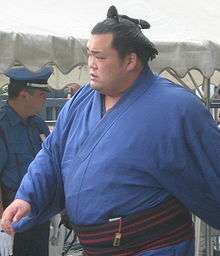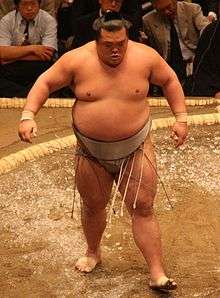Toyohibiki Ryūta
| Toyohibiki Ryūta | |
|---|---|
| 豊響 隆太 | |
 | |
| Personal information | |
| Born |
Ryūta Kadomoto November 16, 1984 Yamaguchi, Japan |
| Height | 1.85 m (6 ft 1 in) |
| Weight | 185 kg (408 lb; 29.1 st) |
| Career | |
| Stable | Sakaigawa |
| Current rank | see below |
| Debut | January, 2005 |
| Highest rank | Maegashira 2 (November, 2008) |
| Championships |
2 (Jūryō) 1 (Jonidan) |
| Special Prizes | Fighting Spirit (3) |
| Gold Stars | 1 (Hakuhō) |
| * Up to date as of Nov 27, 2016. | |
Toyohibiki Ryūta (born November 16, 1984 as Ryūta Kadomoto) is a sumo wrestler from Toyoura, Yamaguchi Prefecture, Japan. He turned professional in 2005, reaching the top division in July 2007. He has earned two special prizes for Fighting Spirit, and one gold star for a yokozuna upset. His highest rank has been maegashira 2. He wrestles for Sakaigawa stable. With the May 2014 promotion of Yoshikaze to komusubi he is now the longest serving makuuchi wrestler to have never earned a titled rank. His ring name roughly translates as "abundant echo".
Early life and sumo background
Kadomoto became interested in sumo in his second year of primary school when he joined an area boys' sports club; also in the club was the future sumo star Hōmashō, three years his senior. Though he showed promise in sumo, preferring to stay local, he did not transfer to one of the more well-known high schools with a strong sumo program. While he was in the sumo club, the owner of Sakaigawa stable visited him with an eye to recruiting him, but did not like his attitude and dismissed him as a candidate. After high school he tried out various jobs such a shipyard work and truck driving. Eventually, however, a dialogue was opened again with Sakaigawa stable and he joined in January 2005. This was the same time that future ōzeki Gōeidō also joined the stable.[1]
Career
He made his professional debut in January 2005, initially fighting under his own surname of Kadamoto. He won the jonidan championship in his second full tournament with a perfect 7-0 record. He recorded only one make-koshi or losing score on his way to elite sekitori status, which he achieved two years after his debut, upon promotion to the jūryō division in January 2007. To mark the occasion he adopted his present ring name of Toyohibiki. The "toyo" part of his ring name came from the name of his home area of Toyoura (the same "toyo" also being the first character in his mother's name Toyomi) and the second part came from the name of his high school, Yamaguchi Hibiki. He won the jūryō championship in his debut tournament with a 10-5 record, and reached the top makuuchi division for the first time in July 2007.
Toyohibiki produced a strong 11-4 record on his debut in makuuchi and was awarded the Fighting Spirit prize. He was one of seven wrestlers who NHK commentator Shuhei Nagao (the former Mainoumi) in 2008 called the "Seven Samurai" and identified as "holding the key" to a Japanese resurgence in sumo, which was dominated by foreigners in the top ranks.[2] (The others were his stablemate Gōeidō, Kisenosato, Kotoshogiku, Homasho, Toyonoshima and Tochiozan) .One of the heaviest men in the division at 173 kg (381 lb), he is a wrestler with great power but he also has suspect footwork. In the next four tournaments after his top division debut, he did not manage a majority of wins against losses. His 5-10 score in the March 2008 tournament, after losing to his first seven opponents, sent him to the bottom of makuuchi and placed him in danger of demotion from the top division altogether. In May 2008 he won six of his first seven bouts and though he stumbled rather through the rest of the tournament he did finally record a winning score of 8-7. In July 2008 he was on the tournament leaderboard into the second week and finished on 10-5, winning his second Fighting Spirit Prize. In November 2008 he reached his highest rank to date of maegashira 2, but he had to sit out the tournament due to a detached retina in his left eye.
Toyohibiki returned to action in January 2009 but could win only five bouts, resulting in demotion back to the jūryō division. He bounced back with a 12 - 3 victory in the jūryō division in the Haru basho in Osaka on March 29, 2009, his second yusho in the division, which returned him immediately to makuuchi. He produced a strong 11-4 record at maegashira 11 in the May 2009 tournament, and was promoted back to maegashira 2 for the July tourney.
In the January 2010 tournament he broke a run of three consecutive make-koshi that had seen him slip to maegashira 16 by finishing joint runner-up (alongside Hakuho and Baruto) on 12-3, and he was awarded the Fighting Spirit prize for the third time. He was suspended along with over a dozen other wrestlers from the July 2010 tournament after admitting involvement in illegal betting on baseball. As a result, he fell to the jūryō division in September. After two tournaments in the second division he returned to makuuchi in January 2011.
In the May 2012 tournament he recorded his first victory over a yokozuna, defeating Hakuho by kotenage or armlock throw. The referee initially awarded the match to Hakuho, but the judges overturned the decision.[3] Since then, he has largely alternated winning and losing tournaments. Toyohibiki is a demonstrated makuuchi regular but it also an active wrestler with one of the longest tenures in the top division without ever making san'yaku. He fell to jūryō in September 2015 for the first time since his suspension in 2010 but made an immediate return to makuuchi.

He is from Sakaigawa stable, which has four other wrestlers with top division experience: Myōgiryū, Sadanofuji, Sadanoumi and Gōeidō, the last of whom joined at the same time as him.
Fighting style
Toyohibiki favours pushing techniques, using his weight to his best advantage. Of the 44 matches he won between July 2007 and May 2008, 24 were by oshi-dashi, or a simple push out.[4] He is not fond of grips on the mawashi, winning only three bouts by yori-kiri or force out during the same period.
Career record
| Year in sumo | January Hatsu basho, Tokyo |
March Haru basho, Osaka |
May Natsu basho, Tokyo |
July Nagoya basho, Nagoya |
September Aki basho, Tokyo |
November Kyūshū basho, Fukuoka |
|---|---|---|---|---|---|---|
| 2005 | (Maezumo) | East Jonokuchi #32
5–2 |
East Jonidan #94
7–0 Champion |
West Sandanme #86
6–1 |
West Sandanme #29
5–2 |
East Sandanme #7
6–1 |
| 2006 | West Makushita #32
3–4 |
East Makushita #40
6–1 |
East Makushita #17
4–3 |
East Makushita #12
5–2 |
East Makushita #8
5–2 |
West Makushita #3
4–3 |
| 2007 | East Jūryō #14
10–5–PPP Champion |
West Jūryō #8
8–7 |
West Jūryō #6
10–5 |
West Maegashira #14
11–4 F |
East Maegashira #6
7–8 |
East Maegashira #7
7–8 |
| 2008 | West Maegashira #8
6–9 |
East Maegashira #11
5–10 |
West Maegashira #15
8–7 |
East Maegashira #13
10–5 F |
East Maegashira #5
8–7 |
East Maegashira #2
Sat out due to injury 0–0–15 |
| 2009 | East Maegashira #14
5–10 |
West Jūryō #3
12–3 Champion |
West Maegashira #11
11–4 |
West Maegashira #2
3–12 |
West Maegashira #9
6–9 |
West Maegashira #12
5–10 |
| 2010 | West Maegashira #16
12–3 F |
East Maegashira #5
4–11 |
West Maegashira #8
8–7 |
West Maegashira #6
Suspended 0–0–15 |
West Jūryō #3
7–8 |
West Jūryō #4
11–4–PP |
| 2011 | West Maegashira #15
9–6 |
West Maegashira #12
Tournament Cancelled 0–0–0 |
West Maegashira #12
7–8 |
West Maegashira #12
8–7 |
West Maegashira #8
6–9 |
East Maegashira #11
9–6 |
| 2012 | West Maegashira #5
7–8 |
West Maegashira #7
9–6 |
East Maegashira #3
5–10 ★ |
West Maegashira #7
9–6 |
West Maegashira #4
7–8 |
West Maegashira #5
9–6 |
| 2013 | East Maegashira #3
5–10 |
West Maegashira #7
6–9 |
West Maegashira #10
8–7 |
East Maegashira #8
9–6 |
East Maegashira #4
6–9 |
East Maegashira #7
9–6 |
| 2014 | West Maegashira #3
5–10 |
East Maegashira #7
6–9 |
East Maegashira #11
8–7 |
West Maegashira #8
8–7 |
East Maegashira #5
8–7 |
West Maegashira #2
5–10 |
| 2015 | West Maegashira #6
3–12 |
East Maegashira #15
8–7 |
West Maegashira #12
6–9 |
East Maegashira #14
5–10 |
East Jūryō #3
10–5 |
West Maegashira #13
7–8 |
| 2016 | West Maegashira #14
8–7 |
East Maegashira #9
3–12 |
East Jūryō #2
9–6 |
East Maegashira #13
7–8 |
West Maegashira #13
6–9 |
West Maegashira #15
6–9 |
| Record given as win-loss-absent Top Division Champion Retired Lower Divisions Sanshō key: F=Fighting spirit; O=Outstanding performance; T=Technique Also shown: ★=Kinboshi(s); P=Playoff(s) | ||||||
See also
- List of active gold star earners
- List of sumo tournament second division champions
- Glossary of sumo terms
- List of active sumo wrestlers
References
- ↑ Sumo Journal, October 2013 edition
- ↑ Alexander Hermann (February 2008). "Ones to Watch-Haru 2008" (PDF). Sumo Fan Magazine. Retrieved 2008-04-14.
- ↑ "Toyohibiki upsets Hakuho". Japan Times. 13 May 2012. Retrieved 16 May 2012.
- ↑ "Top Ten Techniques Used By Toyohibiki During The Last Six Tournaments". Japan Sumo Association. Retrieved 2008-05-31.
- ↑ "Toyohibiki Ryuta Rikishi Information". Sumo Reference. Retrieved 2013-01-27.
External links
- Toyohibiki Ryūta's official biography (English) at the Grand Sumo Homepage